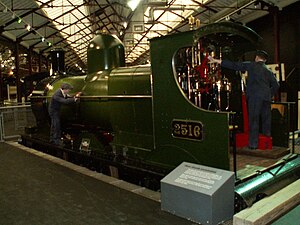GWR 2301 Class
This article includes a list of general references, but it lacks sufficient corresponding inline citations. (December 2014) |
| GWR 2301 Class | |||||||||||||||||||||||
|---|---|---|---|---|---|---|---|---|---|---|---|---|---|---|---|---|---|---|---|---|---|---|---|
 2516 preserved as a static exhibit in the Swindon steam museum | |||||||||||||||||||||||
| |||||||||||||||||||||||
| |||||||||||||||||||||||
| |||||||||||||||||||||||
| |||||||||||||||||||||||
The Great Western Railway (GWR) 2301 Class or Dean Goods Class is a class of British 0-6-0 steam locomotives.
Swindon railway works built 260 of these goods locomotives between 1883 and 1899 to a design of William Dean. The 2301 class broke with previous GWR tradition in having inside frames only and changes were made in the boiler design during the period that they were being built. The first twenty engines were originally domeless though all were provided with domed boilers in due course. They were numbered 2301–2360 and 2381–2580 (2361–2380 were of the 2361 class, which were similar visually but had outside frames).
War Service
In 1917, 62 engines were taken over by the Railway Operating Division and sent to France. 46 of these engines returned to England in the early summer of 1919, but the other 16 had been sent on to Salonika at the beginning of 1918. Two of these engines, nos 2308 and 2542, were sold to the Ottoman (Aiden) Railways[disambiguation needed] and renumbered 110 and 111. No 111 was withdrawn in September 1929, but 110 lasted until the 1950s. Of the 14 engines remaining at Salonika, six were written-off and the other eight returned to England in April 1921.
At the outbreak of the Second World War, the War Department requisitioned 100 of these engines from the GWR and the GWR had to hastily reinstate some engines that had been recently withdrawn. The requisitioned engines were fitted with Westinghouse brakes and 10 were fitted with pannier tanks and condensing gear. All were painted black with their WD numbers painted on. In December 1940, the War Department requisitioned a further 8 engines.
At the time of the German invasion of France, 79 of these engines had been shipped to France. Some of the engines were destroyed in the retreat to Dunkirk whilst the remainder were used on the French railways by the German occupation forces. After the war, between 22 and 26 engines were sent to China under UNRRA auspices, and 30 were returned to the UK, but were deemed unfit for service and scrapped. No.2435 (WD no.188) was used in Silesia and then Austria until 1948 when it was claimed by the Russians before being handed back to the Austrians in 1952. Two further engines, nos. 2419 and 2526 (WD nos. 106 and 132) were used by "Gedob" The General Direktion for the German Ost Bahn (Eastern Railway) headquartered in Krakow. The Ostbahn included Direktion's (Regions) in Occupied Poland, Ukraine, Crimea and The Baltic States. All being converted to standard gauge by the Gedob. Ostbahn regions in the former Soviet Union included RVD Riga, RVD Minsk, RVD Kiev, RVD Poltawa (Rostow) and RVD Djnepropetropwsk (Crimea). Ostbahn Directions in occupied Soviet territory were closed as the Soviet Advance moved toward Berlin between 1942 and the end of 1944. WD 132 was noted in 1945 in store at Hassfurt (Bavaria). Various locations in Northern Bavaria were used for storage at this time including locomotives and roiling stock - by 1945 the Ostbahn HQ was located in Bayreuth (Bavaria). No 132 was shown amongst the stock inventory of the Deutsche Bundesbahn in 1950 allocated to Aachen West Depot (Stored as withdrawn). Was WD 132 in the process of being returned to the UK movements and locations in 1945 would indicate it was being returned and may have failed at Aachen.[citation needed] The remaining engines are assumed to have been scrapped.
Of the engines that remained in England, most of them worked at War Department and Ordnance depots around the country, though in 1943, 6 were shipped to Tunisia and thence to Italy.
Some locomotives of the class have the unusual distinction of being shipped overseas in both World Wars. 32 of the 108 locomotives requisitioned during the Second World War had been previously requisitioned during the First World War, and of those 32, 24 were again sent overseas.[1]
British Railways

Fifty-four locomotives passed to British Railways in 1948, mostly being used on Welsh branch lines due to their light axle loads. They were progressively replaced by new BR standard class 2 2-6-0 engines, and no 2538 was the last to be withdrawn in May 1957.
Preservation

One locomotive, no. 2516 (built 1897), survived into preservation. It is currently a static exhibit at Swindon Steam Railway Museum, with the tender displayed far behind; visitors consequently have a clear view into the driving cab (see pictures).
References
- ^ Pigott 2014, pp. 58–59.
Sources
- Tabor, F.J. (February 1956). White, D.E. (ed.). The Locomotives of the Great Western Railway, part four: Six-wheeled Tender Engines. Kenilworth: RCTS.
{{cite book}}: Invalid|ref=harv(help) - Sterndale, A.C.; Parker, L.T.; Smith, C.; Reed, P.J.T.; Tabor, F.J.; Davies, F.K.; Allcock, N.J.; Lucking, J.H. (May 1974). White, D.E. (ed.). The Locomotives of the Great Western Railway, part twelve: A Chronological and Statistical Survey. Kenilworth: RCTS.
{{cite book}}: Invalid|ref=harv(help) - Davies, F.K.; White, D.E. (December 1983). White, D.E. (ed.). The Locomotives of the Great Western Railway, part thirteen: Preservation and Supplementary Information. RCTS. ISBN 0-901115-60-6.
{{cite book}}: Invalid|ref=harv(help) - Davies, Ken (April 1993). The Locomotives of the Great Western Railway, part fourteen: Names and their Origins - Railmotor Services - War Service - The Complete Preservation Story. Lincoln: RCTS. ISBN 0-901115-75-4.
{{cite book}}: Invalid|ref=harv(help) - Pigott, Nick (2 July 2014). "The Engines that won the War". The Railway Magazine. Vol. 160, no. 1, 360. Horncastle, Lincs, UK: Mortons Media. ISSN 0033-8923.
{{cite magazine}}: Invalid|ref=harv(help)
